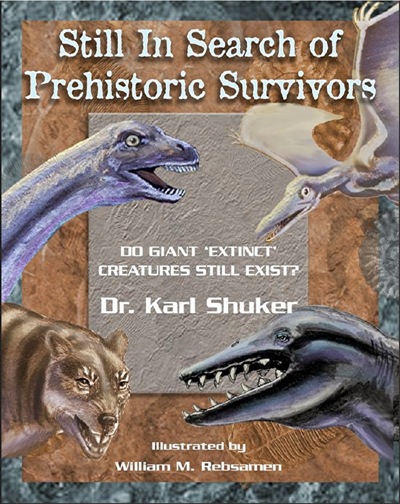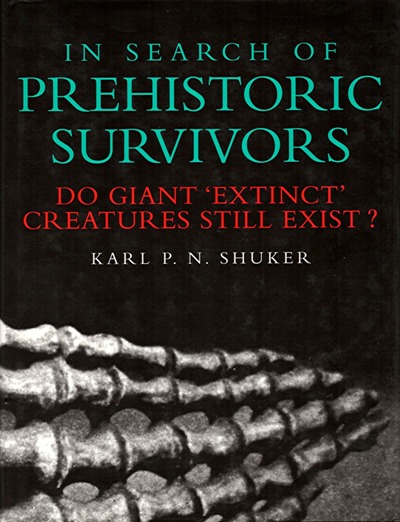In Search of Prehistoric Survivors
Posted by: Karl Shuker on March 4th, 2014
Of all of my 20 books, none has attracted such acclaim but also such controversy as In Search of Prehistoric Survivors. Next year will mark the 20th anniversary of its original publication in 1995, and having received countless requests from readers over the years for its republication (after having been out of print for a number of years now), I am happy to say that following a protracted period of time doing the rounds of prospective publishers, it was accepted for publication just over a year ago, and I am working upon it with a view to its achieving a timely 2015 reappearance.
Having said that, I am still uncertain as to whether to prepare a straight reprint of the text but with additional illustrations (courtesy of the many wonderful ones that have become available to me since 1995), or whether to update it – and, if I do, how extensive that update should be. Mindful of the book’s enormous scope of cryptids (the only major group not represented in it are the man-beasts, and that itself was only for reasons of limited space), a major update would see the book’s size grow dramatically, to the point where it might simply be financially unviable to produce it. So I need to reflect further upon that. Nevertheless, after having received so many enquiries, I can definitely confirm that Prehistoric Survivors will be returning, so watch this space!

A stunning cover design prepared by cryptozoological artist William Rebsamen for a proposed updated, retitled edition of In Search of Prehistoric Survivors (© William Rebsamen)
Meanwhile, and after having given the matter much thought, I feel that it may be instructive to reveal precisely how this particular book of mine came to be, because ever since it appeared in 1995 there has been a degree of confusion and controversy in some quarters as to where I stand in relation to its theme and contents. Consequently, I hope that the following explanation (which I have already outlined privately to various colleagues down through the years but have never bothered disclosing publicly before) elucidates all of this satisfactorily.
In many ways, this book is the most unusual of any of mine, inasmuch as its final, published form was not how I had originally conceived it at all. Let me explain. Following the publication in 1991 of my second book, Extraordinary Animals Worldwide, I was planning a major book on herpetological cryptids – everything from alleged living dinosaurs, pterosaurs, and plesiosaurs, to mystery lizards of many kinds, giant snakes and crowing serpents, chelonian cryptids of all shapes and sizes, anomalous amphibians, and even a major section devoted to the possible origin of and inspiration for the world’s plethora of legendary dragons.
A synopsis of this proposed book did the rounds of publishers (during which time, incidentally, my third book, The Lost Ark: New and Rediscovered Animals of the 20th Century, was published, in late 1993), with Blandford Press being particularly interested in it (and ultimately publishing it two years later). Mindful, however, of the enormous worldwide popularity of Steven Spielberg’s blockbuster movie Jurassic Park at that time (the first film had been released in 1993), they suggested a fundamental change to the contents and slant of my book. Instead of confining it to herpetological mystery beasts, they proposed that I should expand its range of subjects to that of cryptids spanning the entire zoological spectrum, but concentrate exclusively upon those that have been suggested at one time or another by cryptozoologists to constitute prehistoric survivors.
It was certainly a most intriguing brief, albeit very different from my original concept, and one that I therefore decided to accept, even though – and I must emphasise this unequivocally here – I did not personally consider it likely that all of those cryptids truly were prehistoric survivors. But my personal opinion was irrelevant as far as the book’s brief was concerned. What was required was for me to present a dossier of reports and native traditions for each cryptid, and then assess them in the context of whichever prehistoric creature(s) it had been likened to in the cryptozoological literature (with theories not appertaining to prehistoric survival receiving only minimal treatment, as they were not the focus of this study). So that is precisely what I did. Consequently, out went most of the mystery lizards and amphibians as well as the snakes and also the dragons section, and in came putative mammalian methusalehs like chalicotheres, thylacoleonids, amphicyonids, and sabre-tooths, alleged lingering avians like teratorns and Sylviornis, the giant carnivorous shark megalodon, and even some reputed eurypterid survivors.
During the years that have followed, the concept of prehistoric survivorship – or what British palaeontologist Dr Darren Naish refers to as the Prehistoric Survivor Paradigm (PSP) – has received some harsh criticism from cryptozoological sceptics. And indeed, I am the first to concede that such survival becomes increasingly untenable the greater the span of time that exists between any modern-day cryptid and its most recent alleged fossil antecedents (i.e. its so-called ghost lineage, with the cryptid itself thereby constituting a Lazarus taxon). However, as my trilogy of books on new and rediscovered animals have disclosed time and again, some truly extraordinary, spectacular, and entirely unpredictable, unexpected zoological discoveries have been made in modern times.
And yes, these do indeed include some bona fide prehistoric survivors, taxa known only from fossils until living representatives were unveiled – e.g. the Chacoan peccary, mountain pygmy possum, Bulmer’s fruit bat, kha-nyou, goblin shark, neoglyphean crustaceans, monoplacophoran molluscs, and of course the coelacanth. (And yes again, I am well aware that post-Mesozoic coelacanth fossils are now known, but these were only uncovered and recognised for what they were after the discovery in 1938 of the living Latimeria, when the unexpected resurrection of this ancient lineage of fishes no doubt acted as a significant spur to palaeontologists to seek post-Mesozoic coelacanth fossils that they now knew must exist if suitably preserved, and which would help to close up what could now be seen to be a very extensive and therefore anomalous ghost lineage for these fishes; so at its time of discovery, the modern-day coelacanth was definitely a valid prehistoric survivor.) Hence I remain reluctant to discount PSP out of hand.
Having said that, although I have often been accused of “believing” that a given cryptid is a particular type of prehistoric survivor, this is simply not true, for the simple reason that it is impossible to state definitely (although certain cryptozoologists habitually attempt to do so) what a given cryptid must be. Without tangible evidence to examine (and I am referring here to physical remains, not photographic evidence, which can be convincingly faked with alarming ease nowadays), all that can be done is pass a personal opinion as to how likely or unlikely a given identity appears to be. However, opinions are not facts, and should never be put forward, or be mistaken, as such. In short, therefore, I do not “believe” that any cryptid is any specific identity – I merely indicate what I personally consider to be likely (or unlikely) identities for it, nothing more.
Read the rest of the story at ShukerNature.
About Karl Shuker
My name is Dr Karl P.N. Shuker. I am a zoologist (BSc & PhD), media consultant, and the author of 25 books and hundreds of articles, specialising in cryptozoology and animal mythology. I have a BSc (Honours) degree in pure zoology from the University of Leeds (U.K.), and a PhD in zoology and comparative physiology from the University of Birmingham (U.K.).
I have acted jointly as consultant and major contributor to three multi-author volumes on cryptozoology and other mysterious phenomena.
I am the Life Sciences Consultant to The Guinness Book of Records/Guinness World Records (Guinness: London, 1997-present day), and was consultant to Monsters (Lorenz Books: London, 2001), as well as a contributor to Mysteries of the Deep (Llewellyn: St Paul, 1998), Guinness Amazing Future (Guinness: London, 1999), The Earth (Channel 4 Books: London, 2000), and Chambers Dictionary of the Unexplained (Chambers: London, 2007).
I appear regularly on television & radio, was a consultant for the Discovery TV series Into the Unknown, and a question setter for the BBC's quiz show Mastermind.
I am a Scientific Fellow of the Zoological Society of London, a Fellow of the Royal Entomological Society, a Member of the Society of Authors, and the Cryptozoology Consultant for the Centre for Fortean Zoology (CFZ).
I have written articles for numerous publications, including Fortean Times, The X Factor, Paranormal Magazine, FATE, Strange Magazine, Prediction, Beyond, Uri Geller's Encounters, Phenomena, Alien Encounters, Wild About Animals, All About Cats, All About Dogs, Cat World, etc.
In 2005, I was honoured by the naming of a new species of loriciferan invertebrate after me - Pliciloricus shukeri.











Any chance this will be available as an ebook?